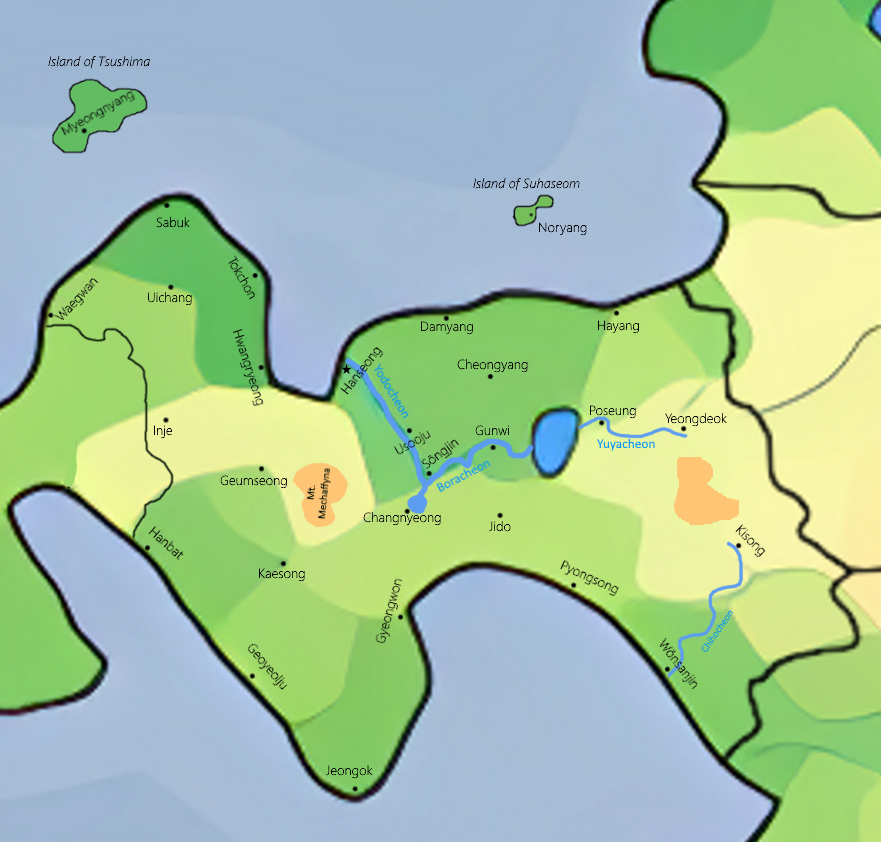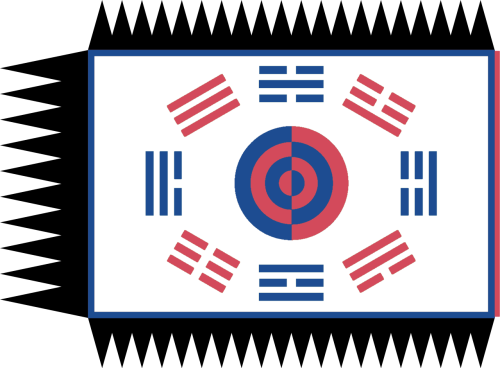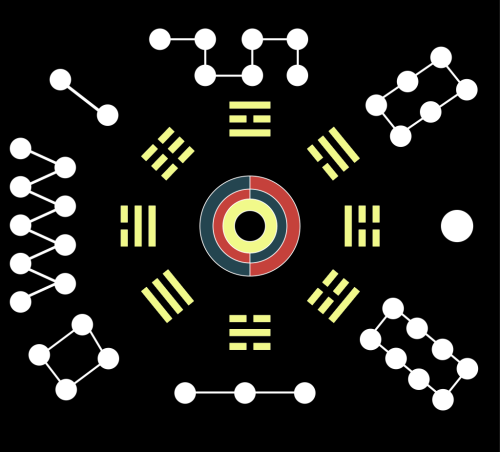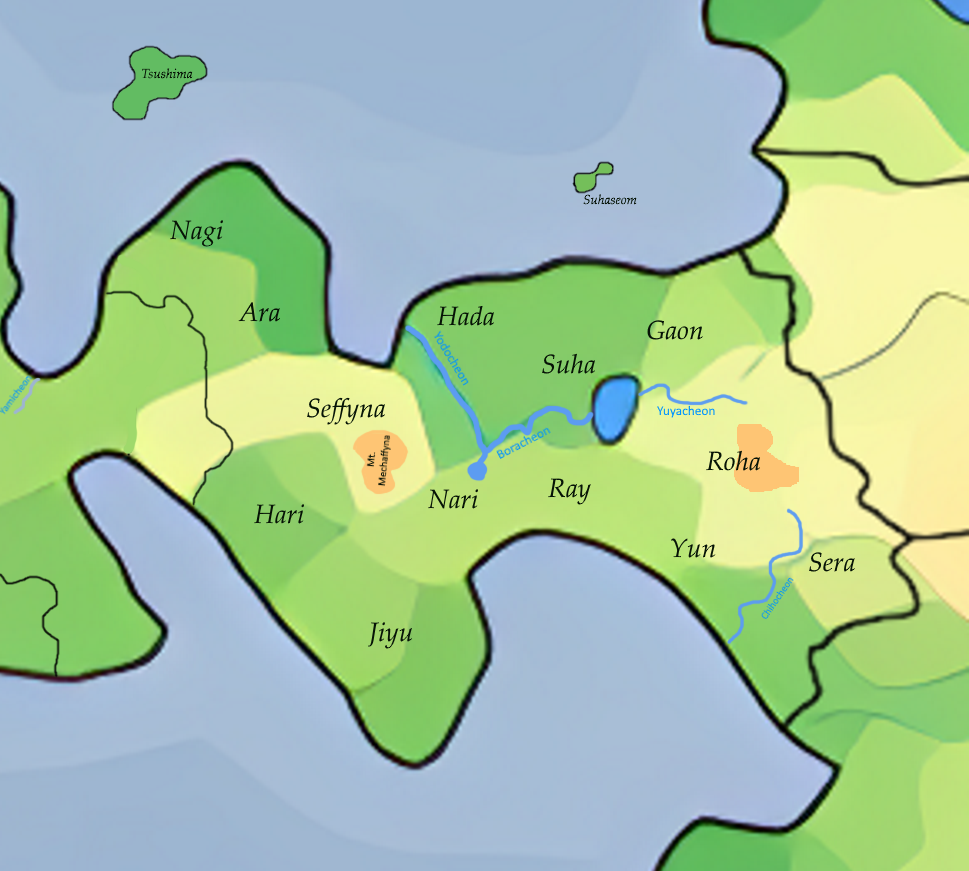The Kingdom of Mujigae
 Map of the Kingdom
Map of the Kingdom
 National Flag
Brief History:
National Flag
Brief History:
The Kingdom of Mujigae used to be the sole power in Goryeo until it's the corruption of its bureaucracy, raids from tribes, and dynastic instability led to its collapse and division in 1045 VTE. As of now, it has restabilized itself with the assistance of the Mononobe Shogunate into its current form.
Government:
Due to the reforms of the King Yi Seong-shin (1088 to 1112 VTE), the once corrupt bureaucracy of the old Kingdom has been reformed into a highly centralized, Neo-Majimite form. The King has absolute power but is supposed to be heavily advised by his council on affairs and in touch with his people as the Celestial King. For example, the King's own failings are the causes of natural disasters and thus a wise ruler shall always seek criticism, petitions, and support from the people of his nation. Royal power is limitless, but a wise ruler uses his power for the benefit of his people.
The Bureaucratic system is based now on extensive examinations and schooling in Neo-Majimite thought and has 20 levels based on examinations and recommendations. These Bureaucrats are in charge of the carrying out of the Divine Orders of the King, and are expected to be principled, bribeless and efficent in their tasks. Those who do not meet the Neo-Majimite Standards are sentenced to death after a trial.
The Judicial system currently is based upon the Code of Seong-shin, written by the King late in his life. This will be more detailed in a separate piece.
From the King down, power is distributed by provinces to departments to districts/special cities down to settlements.
The Island of Tsushima is unique in that it has semi-autonomy from the government and is ruled by a Feudal Lord.
The current King Yi Seong-Jong took the throne in 1112 VTE and has shown great promise as ruler.
Diplomacy:
While not directly hostile to the breakaway states, the King of Mujigae does not formally recognize them as their own Kingdom as rather refers to them as his vassals. This is rather insulting to the two other Kingdoms but has been accepted somewhat as the vanity of the foolish Kings of Mujigae. Beyond this, trade does occur between the three realms, and all have embassies with each other.
What can be said however, is the Kingdom of Mujigae itself is a vassal state of the Mononobe Shogunate. Before the collaspe, the Kingdom was a merely tributary to the Empire. But after the collapse, it was the mercenaries and navy of the Shogunate that prevented the total collapse of the dynasty when it intervened in 1046. The Kingdom pays tribute to the Shogun and the Shogunate conducts most of the Kingdom's world diplomacy. There have been negotiations between both sides to grant further autonomy to the Kingdom, especially regarding foreign diplomacy, but the Shogunate has made it clear that the Kingdom is part of the Empire of Nijisanji's greater holdings now, and that their autonomy is guaranteed by the Shogunates forces.
Armed Forces:
The Royal Army is made up largely of feudal levies armed with Matchlocks and spears, with professional troops being rather small. Cavalry is mostly foreign mercenaries, and the land artillery is mostly out of date, aside from the big guns that the Shogunate installed at harbors.
 Army War Flag
The Navy is quite different, both in professionalism and quality. The Shogunate has made major efforts to modernize the fleet and along with local engineers have designed unique warships to go along with the Ships of the Line.
Army War Flag
The Navy is quite different, both in professionalism and quality. The Shogunate has made major efforts to modernize the fleet and along with local engineers have designed unique warships to go along with the Ships of the Line.
 Naval Jack
The Prince of Tsushima has his own navy and army as well, that are different than the Royal Army and Royal Navy
Naval Jack
The Prince of Tsushima has his own navy and army as well, that are different than the Royal Army and Royal Navy
Further detail will be provided in a separate work.
Economy:
The Kingdom's Economy, in shambles for many years, has slowly recovered as a whole over the years. Trade is extremely important to the economy's growth as is foreign investment.
The agricultural sector is largely concentrated around the farming of Wheat, Barley, Rye, Potatoes and Oats; with the areas of the highest concentration of farms being in the Hada, Suha, Goan, Nari and Ray Provinces. Livestock such as cattle and goats are found in all regions to a degree but especially in the Provinces of Nari, Jiyu and Hari.
The Logging Industry is flourishing thanks to the abundance of wood in the Kingdom, with extensive operation coming from the Yun, Roha, Sera, Seffyna, and Ara provinces.
Mining has always been a backbone of the economy but has exploded in recent years thanks to the K.A.G.'s discovery of the richness of the Mechaffyna Mountains. These mountains, which had been previously untouched, have almost supernatural amounts of Gold, Silver, and Copper; and many other precious gems like Diamonds, Rubies, Emeralds, Sapphires, Aquamarine, Lazurite, Jadeite, and Tsavorite. Rumor says this is the work of the evil spirit which the mountain range is named after, Mechaffyna. Beyond the precious metals and gems that come from these mountains, there are great deposits of anthracite and bituminous coal, found in the across the Kingdom that has the potential for the economy to boom in the future.

The secondary sector is a developing one that is seeing major growth in cities along the greater Yodocheon river system. The steel, chemical, alcohol, weapons and glass industries are starting to boom in these areas. The Lumber industry is also growing rapidly, with many timbers being used for both the Imperial Fleet and the Royal Fleet; and luxury goods made from wood as well. In the ports of Hanseong, Hwangryeong, Tokchon, Sabuk and Wonsajin, the shipbuilding industry is thriving. Indeed, shipping as a whole is thriving from the many ports of the nation. The future development of machine tools might be crucial to the further industrialization of the nation.
One of the weaker parts of the economy is the infrastructure, which is largely outdated beyond the shipping industry. The hilly lands and past corruption have prevented the state from developing more refined road networks across the nation.
Culture:
Drawing heavy inspiration from Anykarian and (whatever other culture we decide to mix in), the Kingdom takes great pride in its literary works, record keeping, music and art. A separate piece will further detail the beauty of Mujigaen Culture.
Conclusion:
The Kingdom of Mujigae has seen troubled times in recent years but thanks to administrative reforms, investment from the Mononobe Shogunate and the developing economy; is emerging from its darkest days as realm on the cusp of a renaissance. It's ties to the Shogunate are vital for its future and there is little reason for the Kingdom to abandon its greatest friend in search of its own path given the protection and investment provided by them. The rebirth of a nation is at hand, and this nation might eclipse its older counterpart in all but territory.